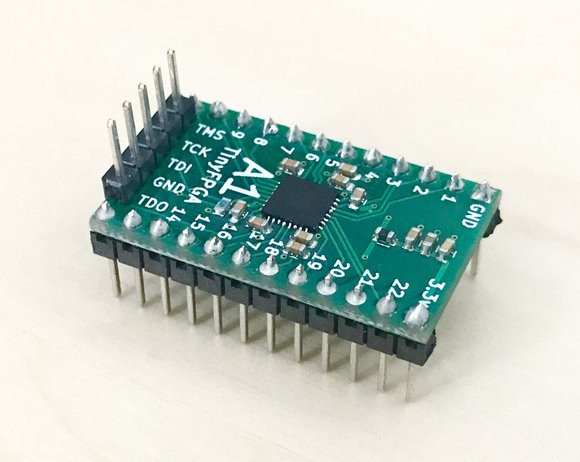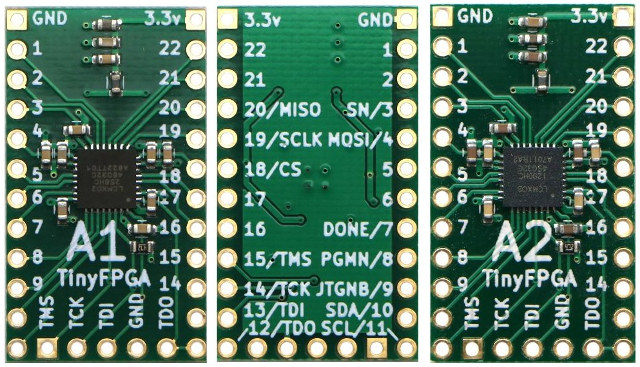We’ve covered several low cost FPGA boards over the years, but if you want a platform with the bare minimum, you may be interested in tinyFPGA breakout board based on Lattice Semi MachXO2 FPGA board that comes with two flavors: A1 with MachXO2-256, and A2 with the more powerful MachXO2-1200 FPGA.
 TinyFPGA board specifications:
TinyFPGA board specifications:
- FPGA
- A1 board – Lattice MachXO2-256 with 256 LUTs, 2 kbits distributed RAM
- A2 board – Lattice MachXO2-1200 with 1280 LUTs, 10 kbits distributed RAM, 64 kbits EBR SRAM, 64 kbits flash memory, and a PLL (See datasheet for MachXO2 family)
- Built-in flash configuration memory programmable via JTAG
- I/Os
- 18 user IOs (21 with JTAGEN)
- 1x SPI Hard-IP
- 2x I2C Hard-IPs
- A2 board only – 1x PLL Hard-IP
- Power Supply – 3.3V
- Dimensions – ~3.05 x 1.8 cm
You’ll need a JTAG programmer for Lattice FPGA as well as Lattice Diamond software – available for Windows and Linux – to program the FPGA board. TinyFPGA boards are open source hardware with KiCAD designs released under a GPL v3.0 license.

TinyFPGA A1 and A2 boards are respectively sold for $12 and $18 on Tindie. The board’s designer is also working on TinyFPGA B1 and B2 boards based on ICE40 FPGAs that come with more logic cells and memory, support Project ICEStorm open source tool, and can be programmed via USB without a JTAG programmer.

Jean-Luc started CNX Software in 2010 as a part-time endeavor, before quitting his job as a software engineering manager, and starting to write daily news, and reviews full time later in 2011.
Support CNX Software! Donate via cryptocurrencies, become a Patron on Patreon, or purchase goods on Amazon or Aliexpress





Cute.
Do keep in mind, there’s not a “lot” you can do with that few LUTs offered. That’s not saying this isn’t a great thing- it is.
Just remember…if you want “fancy”, 7-8k LUTs is your starting point. You can implement a J1, RISC-V, etc. in that sort of space and have some additional parallel logic and code RAM for your softcore with that size.